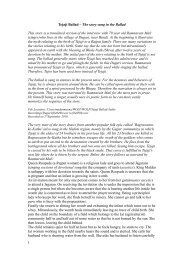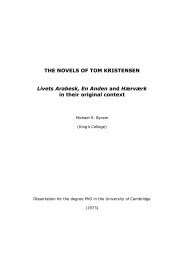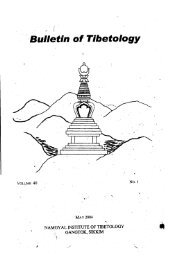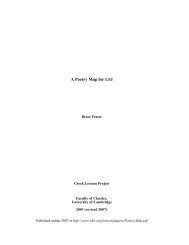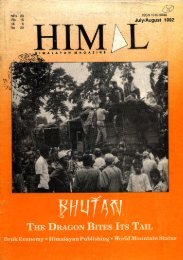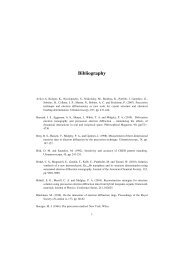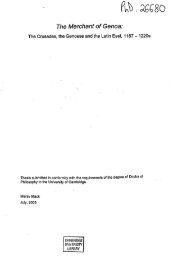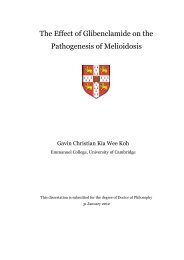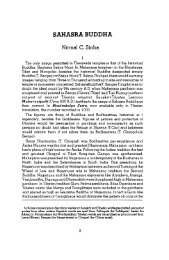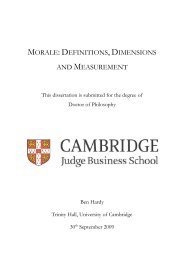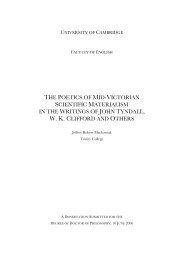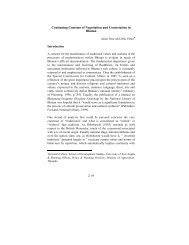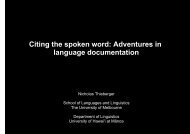Hinayanism
Hinayanism
Hinayanism
You also want an ePaper? Increase the reach of your titles
YUMPU automatically turns print PDFs into web optimized ePapers that Google loves.
fications for its followers by opening the church alike to<br />
the monks as to the householders. By its new ethics, centring<br />
around the Boddichitta and the six paramitas (perfect virtues),<br />
namely, dana, sila, ksanti, virya, dhyana and prajna and<br />
accessibility of Bodhi-sattvahood for all, it struck a tactical<br />
victory over <strong>Hinayanism</strong>. The main difference between<br />
<strong>Hinayanism</strong> and Mahayansim, however, would be the realism<br />
of the former and the negativism or idealism of the latter.<br />
The philosophy of the creed centred around Sunyavada of<br />
which a great exposition had been given in the Madhyamika<br />
doctrine of the celebrated southern monk Acharya<br />
Nagarjuna of the Mahayana school, who should be historically<br />
placed in the middle of the 2nd century A. D. As regards<br />
worship, Mahayanists presented offerings to Tara (Prajnaparamita),<br />
Manjusri, and Avalokitesvara. The accounts of Fa-hien<br />
(c. fifth century A. D.) and Hiuen Tsang (seventh century<br />
A. D.), would tend to suggest that <strong>Hinayanism</strong> in its main<br />
schools of Sarvastivadins, Mahisasakas. Theravadins, Sammitiyas<br />
and Mahasangikas prevailed for quite some time, along<br />
with Mahayana development of the Madhyamika and Yogachara<br />
schools, and among the southern centres are named the<br />
already famous towns in the Andhra country in the Guntur<br />
area like Nagarjunakonda, Goli, Gummididuru, Ghantasala<br />
etc., and Kancipura in Tamilnad. It is interesting to note<br />
that Aryadeva who succeeded Nagarjuna, as his disciple and<br />
one of the four luminaries of India, held charge of Nalanda<br />
as its chief Abbot for many years and is said to have<br />
retired to Kanchi towards the close of his life and passed<br />
away there in the second century A. D. He wrote the<br />
treatise Chatuhsataka.<br />
Buddhapalita was another Mahayana monk from the<br />
South who wrote a commentary on the Mulamadhyamika<br />
sutra of Acarya Nagarjuna. Bhava Viveka, again from the<br />
south, wrote an independent treatise called Tarka Jvala and<br />
essentially followed in all his works the method of Svatantrika,<br />
(direct reasoning) as different from Buddhapalita's method<br />
of Prasangika (reductio-ad-absurdum) on the lines of those<br />
of Nagarjuna and Aryadeva, in treating the thesis of Sunyata.<br />
Another Chandrakirti, also from the south, was again the<br />
Abbot of Nalanda and in his travels in the south he<br />
defeated many teachers in the Konkana tract (from where<br />
he came) and established many monasteries. Of the Yogacara<br />
scholars of Mahayana Buddhism, Vasubandhu is doubtless<br />
the most famous and had a very long career at Nalanda<br />
and counted among his pupils Dinnaga who was originally<br />
12
of a Brahmana family from Kanchipuram, and wrote the<br />
Pram,masamuccaya, Nyayapralesa and PrajnaparamUapindartha.<br />
He lived perhaps towards the end of the fifth century A. D.<br />
or sllghtly later. His own disciple Dharmapala, who was<br />
also a native of Kanchi is quoted by Hiuen Tsang and<br />
Taranatha. He was also in charge of Nalanda Mahavihara.<br />
In the Pali literature relating to the Mahayana Buddhism,<br />
the most significant era may be said to have begun with<br />
the oldest Pali grammar namely Kacct1yana Vyakatana by<br />
Kaccayana, who was a successor to Buddhaghosha and<br />
Dhammapala. As Kaccayana seems to have utilised Kasika<br />
vritti (seventh century A. D.) the upper limit of his age is<br />
thus available. The Dipavamsa and Mahavamsa were composed<br />
during the later part of this epoch. The commentaries<br />
mention Kanchipura, Kaveripattina, Madura, Uragapura and<br />
Anuradhapura as well known centres of Pali Buddhism.<br />
In the realm of art, the important Indian centres (leaving<br />
aside Gandhara--now in Pakistan) of such activjty under<br />
the Mahayana dispensation had been around Ajanta and<br />
E1lora and Aurangabad, in the Upper Deccan, Ter, Chezarla<br />
in the lower Deccan and Lower Krishna basin, Ratnagiri<br />
in Kalingadesa and Kaveripattinam and Nagapattinam in<br />
the Tamil country. It is important to realise that the<br />
architectural forms of the main types of Buddhistic structures<br />
whether rock-cut or of brick and mortar, had been more<br />
or less alike, and comprise the Stupa, Chaitya and Vihara<br />
or Sangharama. While in the rock-cut tradition, inevitably<br />
only the facade and interior receive the greatest ornamentation,<br />
in the brick tradition, the accent is on exterior<br />
ornamentation of even more prolific motifs and elements<br />
than would have been possible on the heavier rock medium.<br />
In the last mentioned place in the Tamil land, however,<br />
the Vihara, which went by the name Chulamani vihara,<br />
enjoying the patronage of the overseas Sailendra king of<br />
Sri Vijaya (palembang), Kataha (Kedah), by Sri Vijayaottungavarma,<br />
whose father's name it was, took the shape<br />
almost of a multi-storeyed Dravida temple, but without its<br />
minor turrets. This was around the second decade of the<br />
11th century A. D. during the time of Raja Raja I. This<br />
monument was razed down by Jesuits for building their<br />
institutions in the last century.<br />
AJANT A: This was verily one of the most glorious<br />
interludes in Buddhist art under Mahayanism in India, when the<br />
13
ush and paint of the artist dedicated itself to Buddhist cause<br />
and was guided by equally persevering monks of Mahayana<br />
order, flourishing in the Vakataka kingdom, whose rainy<br />
season hibernation (Vassa-vasa) was located at Ajanta.<br />
Mahayanism considered Hinayana ArhJtship inadequate and<br />
replaced it by Bodhisattvah)od where guiding others to<br />
salvation is· the supreme goal, engendered by a pervasive<br />
sense of hllmanity. Mahayanism did not certainly bother about<br />
having to import Hindu gods in its pantheon. Indra, who<br />
was already Sakra to Hinayanaism became Satamanya and<br />
Vajrapani under Mahayanism, and his world was the Trayas<br />
trimsaloka, i. e., 33rd. Brahma's attributes were transferred<br />
to Manjusri (the god of wisdom) and Padmapani; Sarasvati<br />
continued to be a consort of the former. Pacm1pani is a<br />
variant of Visnu; Virupaksa, Ganesa, Sapta Tathagatas (seven<br />
sages), Mahakala, Aditya etc., were all duly gathered into<br />
the Buddhist pantheon. The five skandhas or elements that<br />
Buddhists believed in were Rupa, Vedana, Samjna, Samskara,<br />
and Vijnana. These are apotheosised into the five Dhyani<br />
Buddhas complete with their associative counterparts like<br />
Vairocana, Ratnasamthava, Amitatha, Amoghasiddhi and<br />
Aksobhya, and portray the vyakhya, varada, dhyana, athaya<br />
and bhumisparsa mudra respectively. They have their Taras<br />
also. Maitreya or the future Buddha is in the Tusita heavens<br />
and is to descend to earth 4000 years after Gautama Buddha.<br />
He usually holds, in Indian sculpture, lotus in right hand or<br />
Dharmachakra mudra, while his left has a vase. A valokitesvara<br />
is the Bodhisattva who reigns between the time of<br />
Gautama and Maitreya, and is said to take 108 forms all<br />
of which have been elaborated in painting in the Macchandar<br />
Vahel Vihara at Khatmandu, Nepal. Rhys Davids has<br />
remarked that "Mahayana theology is the greatest possible<br />
contradiction to the Agnostic Atheism which is the characteristic<br />
of Gautama's philosophy l'<br />
In the Budchist art at Ajantr t the notable and ubiquitous<br />
elements are: the Nagas; Hariti and Panchika; Buddha's<br />
meeting of Yasodhara and son Rahula; Temptation Scene<br />
of Buddha; river goddesses Ganga and Yamuna; dwarfs;<br />
Apsarases and ganas. The lataka stories are portrayed all<br />
over the walls and repeated over and over again in many<br />
em es. The most outstanding of these Jataka tales depicted<br />
at Ajanta are Sibi lataka and Mahajanaka Jataka, all in Cave<br />
1 (dateable to early seventh century A.D.), and Nalagiri<br />
lataka, Shaddanta lataka, Visvantara Jataka, Nigrodhamlga<br />
Jataka (in Cave 17).<br />
14
ELLORA: The Buddhist Caves at Ellora would seem<br />
to pertain to a period between the sixth and eighth centuries<br />
A.D. This was again an important seat of Mahayana<br />
Buddhism and with the resurgent Brahmanism in the seventh<br />
century A.D. the activity was apparently shifted to Aurangabad.<br />
The litany of Avalokitesvara in Cave No.4 (seventh<br />
century A.D.); Bodhisattva Vajrapani and the shrine of<br />
Padmapani A valokitesvara and the sculpture of Mahamanjusri<br />
in Cave No 8; the litany of Tara in Cave No.9; the Raktalokesvara<br />
shrine and sculpture in Cave No.lO and II-the<br />
latter cave also having the three Bodhisattvas Manjusri,<br />
lnanaketu and Padmapani and what is likely to be Prajnaparamita<br />
(on the third corridor wall); the Buddha Mandala<br />
in cave No. I 2-the largest Buddhist excavation at Elloraincluding<br />
such rare forms as Bhrukuti, Chunda and Vajrasattva,<br />
the sixth Dhyani Buddha flanked by Padmapani and<br />
Vajrapani, are all the most outstanding elements of Mahayanism<br />
and what is clearly the incipient Vajnyana Buddhism<br />
at Ellora.<br />
Ter and Chazarla were apparently the extension in<br />
Mahayana times of the Buddhist activity already set in<br />
motion under the Hinayana votaries in a good many centres<br />
in Andhrapatha of the Satakarnis and their successors in<br />
lower Krishna, as at Nagarjunakonda. These two places<br />
represent perhaps the only two extant vestiges of an almost<br />
complete apsidal brick temple which were originally dedicated<br />
to Buddhism and which by natural supercession of that<br />
creed by nascent Brahmanism, were converted to its use-at<br />
least in the case of the latter. They could perhaps be dated<br />
to the fifth-sixth centuries A.D. This temple at Chazarla is<br />
indeed of the greatest importance from the early architectural<br />
view point. The fact that the temple is called Kapotesvara<br />
and that Sibi lataka is sacred to Buddhism makes<br />
this old Buddhist chaitya of considerable significance. Its<br />
age is supported by an inscription in the temple by Sat<br />
Sabhamalla, the son of Avanitalantavati Mahadevi, the<br />
daughter of the king Kandara of the Ananda gotra line.<br />
This Kandara line is a rare dynasty and appears to have<br />
ruled in the Krishna area around fourth or fifth century<br />
A.D.<br />
AURANGABAD CAVES: The Caves here, about 12<br />
III number are, though not as impressive as those of Ajanta<br />
or Ellora, form indeed an integral stage in the devolution<br />
of the Mahayana pantheon. The litany of Avalokitesvara<br />
15
and the impressive Dance scene in the Cave No.7 are perhaps<br />
the most outstanding examples of its art-expression. There<br />
is no doubt that the sculptors of these caves have already<br />
attained great control over rock-art and were at the same<br />
time caring more for self-expression than for traditional forms.<br />
The entire range of caves is dateable perhaps to the late<br />
seventh to later eighth centuries A.D. There is a Hinayana<br />
Chaitya also (Cave No.4). There is a striking representation<br />
of Mahaparinirvana of the Buddha in Cave No.8 and 9.<br />
NAGARJUNAKONDA: A study of the provenance of<br />
Buddhist sites in South India would show that there were<br />
five main ancient routes which converged in the Vengirastra<br />
and led to Kalinga, Dravida, Kamata, Maharastra and to<br />
Kosala respectively. Necessarily the lower Krishna Valley<br />
was a particularly propitious zone for the proliferation of<br />
the Buddhist creed and River Krishna (Maisolos of the<br />
Greeks) was the life giving arterial water-way that united<br />
together the trading patrons given to far flung voyages and<br />
devoted monks who annihilated distance to spread the gospel<br />
of the Buddha. The vaHey of Nagarjunakonda (in Guntur<br />
District) was discovered in 1936. Since then systematic salvage<br />
excavations for nearly six years from 1954 had to be undertaken<br />
to retrieve all that was historically and archaeologically<br />
valuable in the valley before leaving it to the rising catchment<br />
water level of the giant Nagaljunasagar proJcct; the<br />
hundreds of sites of early Buddhist faith, mostly of Mahayana<br />
that dotted the valley have revealed an outstanding and new<br />
chapter in the history of Andhra Pradesh and of early Buddhism<br />
at Vijayapuri, as the city here was anciently caBed, and at<br />
Sri Parvata as the hill range from here to Srisailam was<br />
also perhaps called. From the scores of inscriptions that<br />
we have here ( one of which would seem to be also of the<br />
time of Yajna' Satakami) which are mostly of the Iksvaku<br />
(Ikkhaku) dynasty-the successors of the Satavahanas here-we<br />
get a glimpse of the remarkable part played by nearly<br />
half a dOL-ell distinguishcd ladies of the royal house and<br />
princesses, who though their lords were patrons of Hinduism,<br />
themselves promoted the cause of Buddhism. We have names<br />
of many viharas of the various denominational sects of<br />
early Buddhism like Bahusrutiya Vihara, Mahisasaka Vihara,<br />
Chula Dharrnagiri Vihara, Aparamahavinaseliya Vihara<br />
Purvaseliya Vihara, Kulaha Vihara and Simhala Vihara, not,<br />
to mention the M aha chetiya in the centre of the valley<br />
which is mentioned as holding in its bosom the corporeal<br />
relics of Lord Buddha himself.<br />
16
Thousands of sculptured panels and friezes in greenish<br />
limestone were recovered from the site, giving us a continuous<br />
bas-relief narration of the life of the Buddha. The scenes<br />
are from both Buddha's life as well as from the Jatakas.<br />
Andhra stu pas are distinguished by the erection of the five<br />
Ayaka pillars on the cardinal directions at the front of the<br />
drum, on the pradakshinapatha. It 1S these which carry<br />
inscribed records often. Inscriptions were mostly in Prakrit,<br />
but Sanskrit records were also found. One of them belonging<br />
to the fourth-fifth centuries A.D. mentions a Dharmakathika<br />
or Dharma narrator by profession who is said to have been<br />
well versed in horoscope casting and for whom the yellow<br />
flag or 'order' furnished amply.<br />
Another inscription from a place called Jaggayyapetta<br />
in Krishna District mentions the setting up of an image<br />
of Buddha in high relief for universal beatitude, by one<br />
Chandraprabha, a pupil of Jayaprabhacharya, who in turn<br />
was a pupil of the venerable Nagarjunacharya. This Nagarjuna<br />
was obviously the later Tantric guru (Siddha Nagarjuna, who<br />
was one of the 84 Siddhas) and not the great founder of<br />
the Madhyamika school. This Nagarjuna was perhaps living<br />
in the fifth century A.D.<br />
A third record from a place called Gummidodurru, also<br />
dateable to the fifth century A.D. which states that for the<br />
universal beatitude, has been set up an image of Bhagat<br />
( Buddha) by Sramana Rahula, pupil of Acharya Dharmadeva,<br />
who in turn was the intimate disciple of Acharya Maudgalyayana.<br />
The information on the relig!ous life of Buddhist monks at<br />
Nagarjunakonda reveals that the Thera Vada (Vibhyya Vada)<br />
school of Ceylonese Buddhism flourished side by side with<br />
Mahayana Buddhism in the valley, although the latter was<br />
dominant.<br />
Here was a typical stupa at Bhattipulu which is said<br />
to have been a Mahastupa enshrining a bone relic of the<br />
Master with flowers of gold and pearls in a crystal casket.<br />
Andhradesa gained a name for producing Buddhist authors<br />
of repute who learned by rote the entire canon and were<br />
known as Dharmakosakas; while the Dharmakathakas delivered<br />
learned discourses on them.<br />
It is accepted, on all hands, that the Mahayana type<br />
became deep-rooted in the soil of central and south India.<br />
Hence, those things, associated with the concept of Buddha<br />
17
Rare Buddhist bronzes have been found in South<br />
India. Of these the earliest was found in Buddhapad<br />
(Indian Antiquary, 1. p. 153) and Amaravati, both in Andhra<br />
Pradesh. These which portray standing Buddha with various<br />
types of drapery have been dated from fourth century<br />
A.D. to sixth century A.D. on stylistic grounds. A fun<br />
cache of bronzes was also discovered some years ago from<br />
Nagapattinam, some of them inscribed, apparently from the<br />
site of old Viharas there. Some of these have been dated<br />
to the ear1y period (870-1070 A.D.) an



